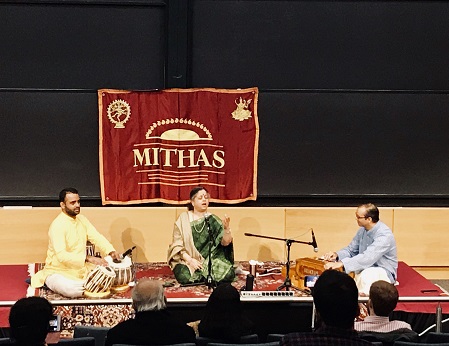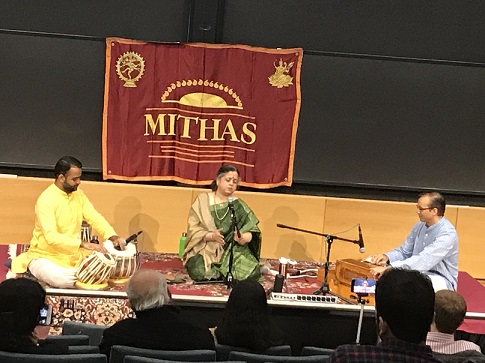Contribute
| Agra Gharana Vocalist Delights Music Lovers In A MITHAS Presentation |
Shuchita Rao
11/06/2019
On a beautiful Sunday afternoon, November 3, at 4pm, MITHAS
presented Vidushi Aditi Kaikini Upadhya in a Hindustani vocal music concert at
MIT’s Wong auditorium, Cambridge, MA. The concert began with New England’s much
loved Sarod player, Dr. George Ruckert’s welcome address to the audience and
introduction of the artists, vocalist Smt. Aditi Upadhya (daughter of the
renowned Agra gharana doyen, the late Pandit Dinkar Kaikini), the harmonium
artist, Shri Neelesh Nadkarni and tabla artist, Shri Kishan Patel. He recalled
an incident from several years ago in San Rafael, California, when his Guru,
the late Ustad Ali Akbar Khan requested him to play the harmonium and accompany
a visiting artist from India, Pandit Dinkar Kaikini. The concert went well and
Pandit Kaikini was happy with the accompaniment on the harmonium. While hearing
the narration of this incident, the audience was reminded of how Indian
classical music concerts are unique because they allow for spontaneous
interactions between artists to happen directly on the stage without prior
rehearsals. That spontaneity allows for the artists and audience to live in the
moment and enjoy music as a shared experience. Dressed in an elegant green silk sari with an oatmeal
colored shawl draped around her shoulders, Vidushi Aditi Kaikini introduced the
first composition as a traditional composition in afternoon raga Bhimpalasi set
to slow tempo twelve beat cycle ektaal and the second one as a Punjabi language
composition set to a faster tempo sixteen beat cycle, teentaal. In a detailed
rendition of raga Bhimpalasi that lasted almost an hour, the artist successfully
created a peaceful atmosphere initially through the medium of Dhrupad style
Nom-Tom alaap. The first part of the alaap was leisurely while the second part
was dynamic in its movement resting for briefer periods of time on important
musical rest notes in the raga. She then rendered the composition “Ub tho sun lay†with the climactic point
of the rhythm cycle synchronizing with the utterance of the word “layâ€. She sang several alaaps (slow
melodic movements), building slowly and steadily from the tonic and notes in
the lower register to movements in the middle and upper register using several
words of the composition. Her open throated, sweet voice and robust
presentation style caught the attention of concert attendee Bruce Scott, who
said that he was also struck by the fluid manner in which she traversed
multiple musical registers. The faster composition was delivered in a brisk
manner, with wonderful rhythmic exchanges with her accompanists, ornamented
gamak taans (fast melodic passages using solfege) and exciting tihais (a short
musical phrase sung thrice consecutively to culminate on the climactic point of
the rhythmic cycle). Next, Vidushi Aditi Kaikini presented a short composition in
Raga Poorvee set to sixteen beat rhythm cycle, teentaal with the words “Banata
Banaaoo†followed by “Saajan Ghur Aayeâ€, a composition by her father, the late
Pandit Dinkar Kaikini, replete with Shringaar (romantic) rasa. With the early
sunset and the darkness setting in, the raga was a perfect choice to create an
atmosphere of longing for the beloved. The alaaps developed with poise and
imagination in the first composition contrasted with the rhythmic interplay of
words and aakaar taans in the second composition brought great joy to the
audience. After a short intermission, in the next segment of the
presentation, two compositions in an ancient raga, MargBihag (raga Bihag sung
in the style of Raga Kalyan) were the first to be rendered. “Maata Saraswati†in praise of the Goddess of
learning and the arts, set to ten beat cycle jhaptaal in the Brij Bhasha
dialect of Hindi language followed by “Pari moray kaan dhanak murli ki taanâ€
describing the magic of Lord Krishna’s skill in playing the bansuri, set
to sixteen beat teentaal, were both
elegant in their architecture. Shri Neelesh Nadkarni shadowed the artist
wonderfully on the harmonium, adding his own imaginative ideas to the
presentation. The next offering was an interesting devotional composition,
a thumri numa bhajan “Kub Aave Ram†where every new verse that narrated the
story of the Hindu epic Ramayana, ended with a fast laggi rhythmic movement,
showcasing the tabla artist’s ability to switch from a fourteen beat cycle
“chaachar†to a faster tempo sixteen beat cycle and back to the fourteen beat
cycle. The artist concluded with the famous thumri in raga Bhairavi
“Babul Mora Naihar Chhooto bhi jaaye†creating a pensive ambience with the
rendition of the touching lyrics. This concert was steeped in pure melody
enhanced by sensitive accompaniment on the harmonium and tabla and without a
trace of gimmicks or theatrics. Kudos to the artists and organizers, MITHAS for
presenting a soul-touching Hindustani music offering.
You may also access this article through our web-site http://www.lokvani.com/

